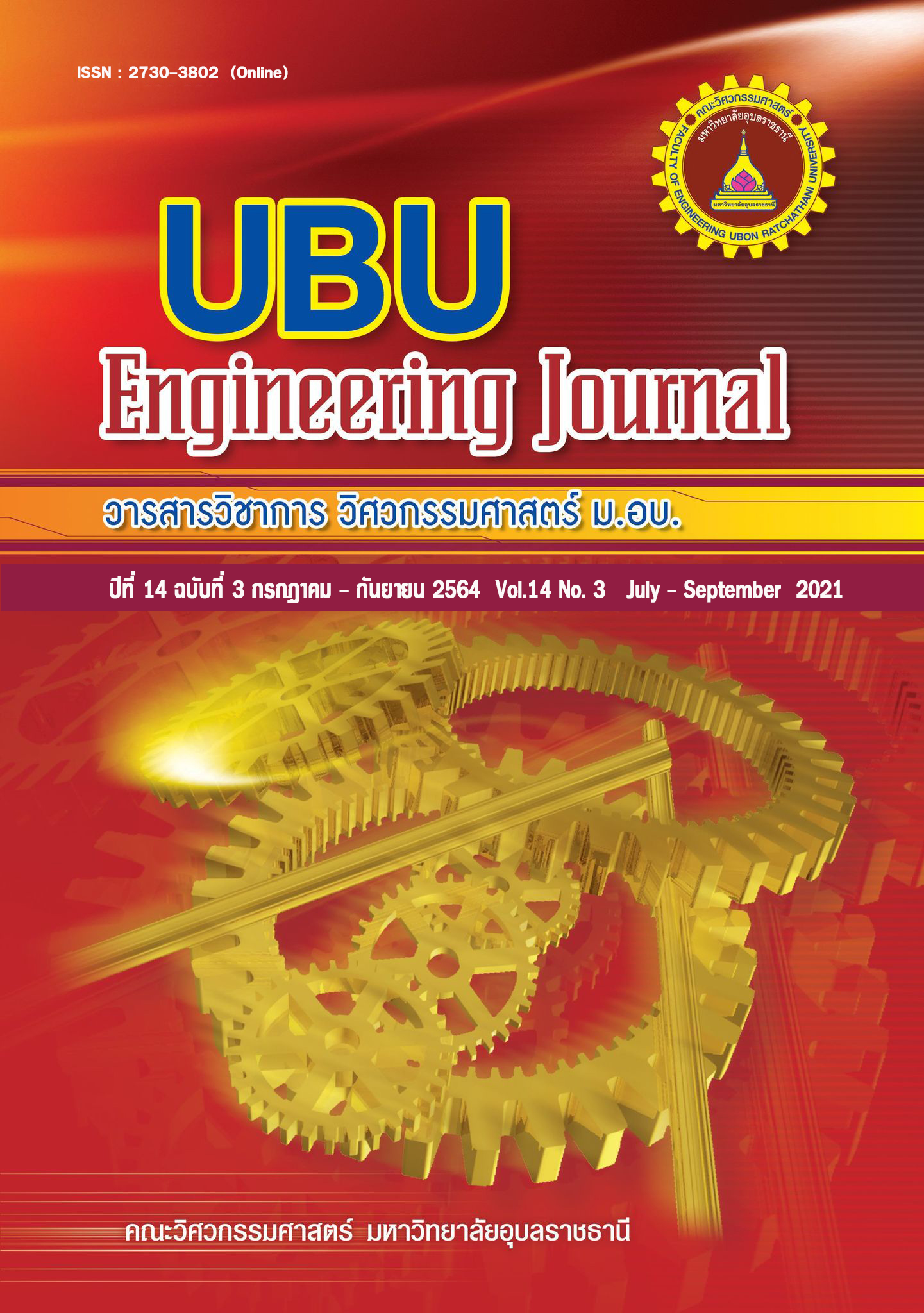Effects of refrigerant pressure level and mechanical failure to vibration signal on an air conditioner
Main Article Content
Abstract
This research investigates the vibration of a split-type air conditioner compressor during on and off modes in order to identify the relationship between the mechanical vibration and the supplied electrical current. Under the controlled room temperature of 25°C, experiments were performed at refrigerant pressure levels of 80, 60 and 40 psi with three scenarios including (1) one bolt used to fix the compressor with the base being removed, (2) all bolts being tightened and (3) evaporator filter being loaded with dust. The results showed for the first scenario that at 80 psi refrigerant pressure the vibration amplitude occurred at 0.037-0.047 mV/g with the compressor electrical current of 3.63-3.68 Amp, whereas the amplitudes occurred at 0.020-0.026 mV/g with the current of 3.44-3.47 Amp for 60 psi and 0.020-0.023 mV/g with 3.17-3.20 Amp for 40 psi. When all bolts were firmly fixed, applying refrigerant pressure of 80 psi led to the amplitude at 0.032-0.034 mV/g in conjunction with 3.62-3.66 Amp compressor current, while the amplitudes were at 0.017-0.020 mV/g and 0.016-0.018 mV/g with the electrical currents of 3.62-3.66 Amp and 3.16-3.18 Amp for 60 and 40 psi, respectively. The final scenario of dusty filter revealed that the vibration amplitude was 0.018393 mV/g corresponding to the compressor current of 3.88 Amp for 80 psi pressure. When the refrigerant pressure was reduced to 60 psi, the vibration amplitude decreased to 0.015673 mV/g with 3.84 Amp of compressor current. Additional decrease of the pressure to 40 psi cause further reduction of the amplitude to 0.010987 mV/g with the electrical current reducing to 3.65 Amp.
Article Details
References
2. กิตติศักด์ สุดดวง, พรชัย นิเวศน์รังสรรค์. การตรวจสอบสภาวะของคอมเพรสเซอร์แบบลูกสูบอัดอากาศสองชั้นด้วยสัญญาณการสั่นสะเทือน. การประชุมวิชาการเครือข่ายวิศวกรรมเครื่องกลแห่งประเทศไทยครั้งที่ 23 ประจำปี 2552, 4-7 พฤศจิกายน 2552. เชียงใหม่; 2552. DRC-013288
3. J. Rens, R. E. Clark, D. Howe. Vibration analysis and control of reciprocating air compressors. Int. J. Appl. Electromagn. Mech. vol. 15. no. 1-4 SPEC. 2001. 155–162.
4. F. ZHAO, X. JING, M. YANG, D. WANG, Y. SHA, and X. LUAN. Experimental study of rotor blades vibration and noise in multistage high pressure compressor and their relevance. Chinese J. Aeronaut. 2019.
5. C. Peng, J. He, M. Zhu, Z. Deng, Z. Zhen, Q. Liu. Optimal synchronous vibration control for magnetically suspended centrifugal compressor. Mech. Syst. Signal Process. vol. 132. 2019. 776–789.
6. อภิเดช บุญเจือ. การศึกษาวิธีการลดพลังงานของคอมเพรสเซอร์เมื่อชุดคอยล์เย็นอยู่ต่ำกว่าชุดคอยล์ร้อน. วิทยานิพนธ์ปริญญามหาบัณฑิต สาขาวิชาวิศวกรรมเครื่องกล ภาควิชาวิศวกรรมเครื่องกล คณะวิศวกรรมศาสตร์ มหาวิทยาลัยเทคโนโลยีราชมงคลธัญบุรี. 2554.
7. ศรายุทธ ทัพแสง. การบำรุงรักษาลิฟท์โดยการวิเคราะห์ความสั่นสะเทือน. วิทยานิพนธ์ปริญญามหาบัณฑิต สาขาเทคโนโลยีการผลิตทางอุตสาหกรรม คณะวิศวกรรมศาสตร์ มหาวิทยาลัยเกษตรศาสตร์. 2549.
8. ปิยะพงศ์ ป่ากว้าง, มนัสศักดิ์ วรรณสิน. การวิเคราะห์การสั่นสะเทือนในส่วนคอมเพรสเซอร์ของระบบปรับอากาศแบบแยกส่วน. ปริญญานิพนธ์วิศวกรรมศาสตรบัณฑิต สาขาวิชาวิศวกรรมเครื่องกล คณะวิศวกรรมศาสตร์ มหาวิทยาลัยมหาสารคาม. 2560.
9. ปรัชญา นวลพลับ. การศึกษาพฤติกรรมของสัญญาณการสั่นสะเทือนกับรูปแบบการสึกหรอของเฟืองตรง. วิทยานิพนธ์ปริญญามหาบัณฑิต สาขาวิชาวิศวกรรมเครื่องกล ภาควิชาวิศวกรรมเครื่องกล คณะวิศวกรรมศาสตร์ จุฬาลงกรณ์มหาวิทยาลัย. 2550.
10. เอกรัตน์ สุขสุคนธ์. การศึกษาและปรับปรุงคุณภาพของสัญญาณเสียงในห้องประชุม โดยใช้การแปลงฟูริเยร์แบบเร็วร่วมกับตัวกรองดิจิตอลจำกัด. วิทยานิพนธ์ปริญญาวิศวกรรมศาสตรมหาบัณฑิต สาขาวิชาวิศวกรรมอิเล็กทรอนิกส์และโทรคมนาคม คณะวิศวกรรมศาสตร์ มหาวิทยาลัยเทคโนโลยีราชมงคลธัญบุรี. 2560.

